
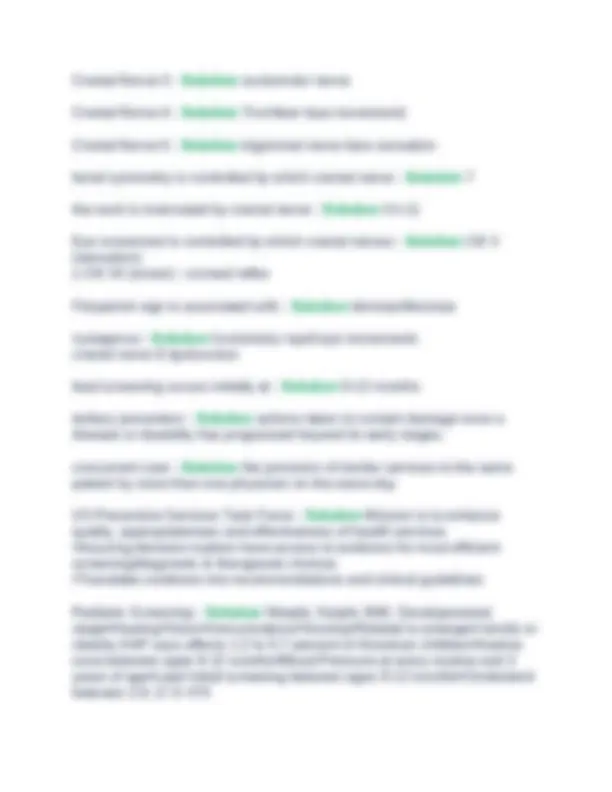
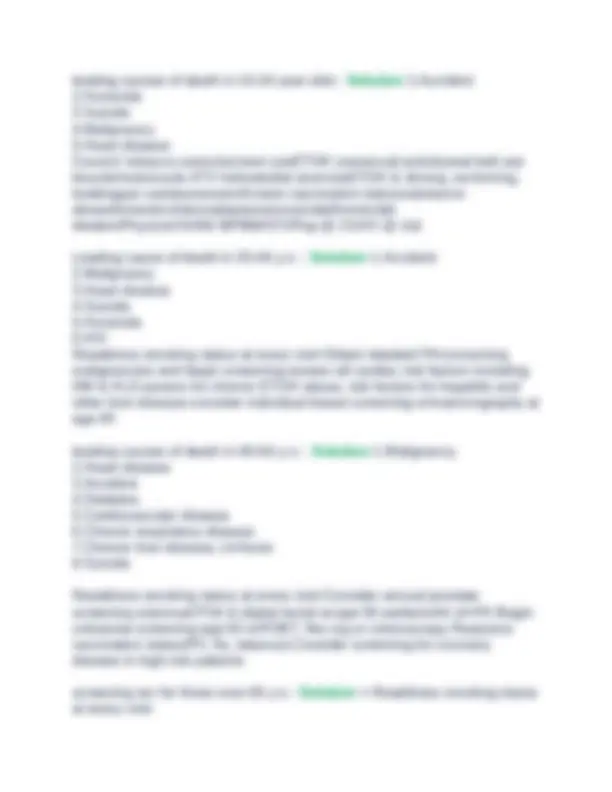
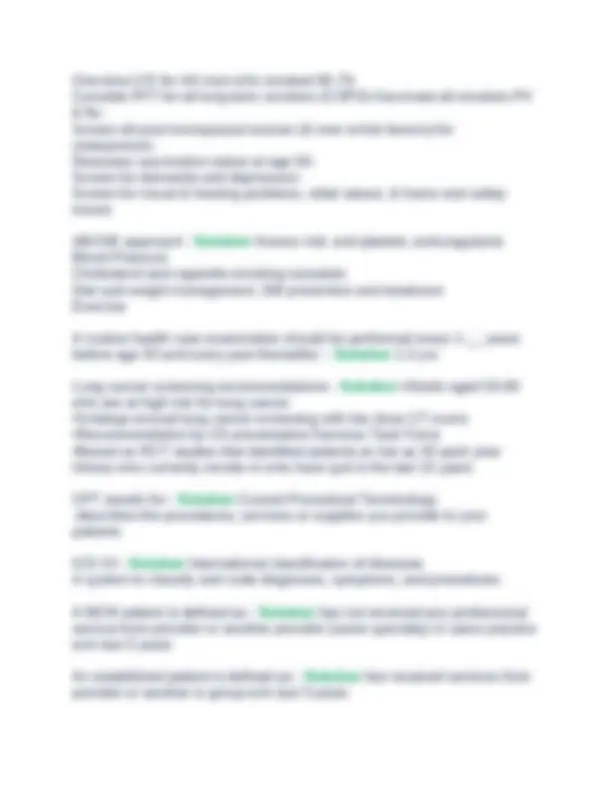
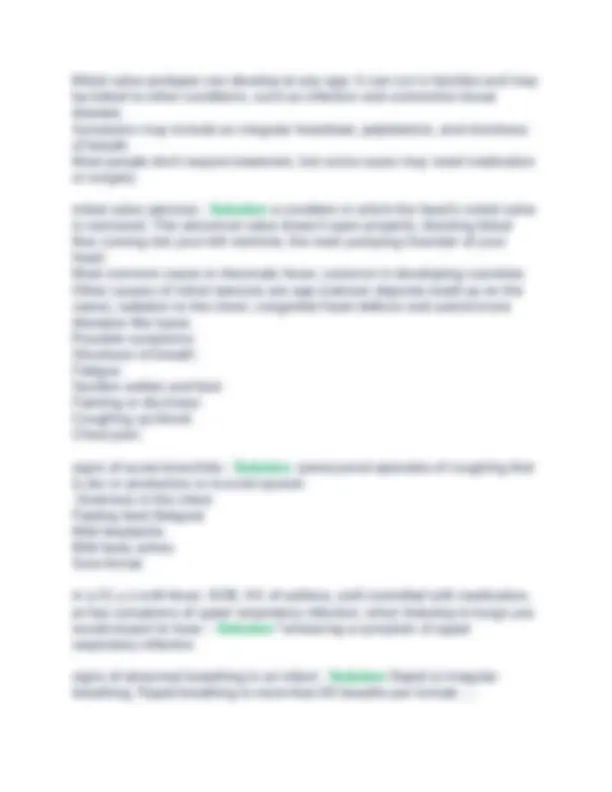
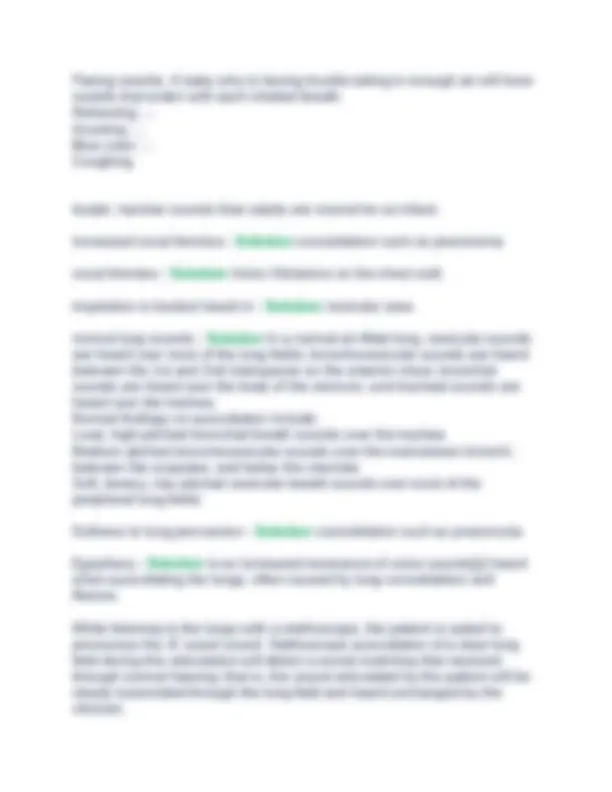

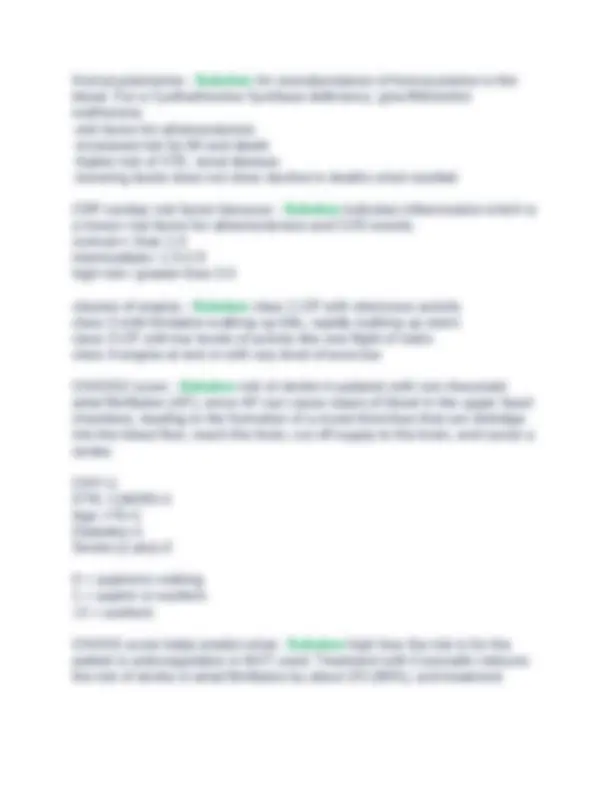
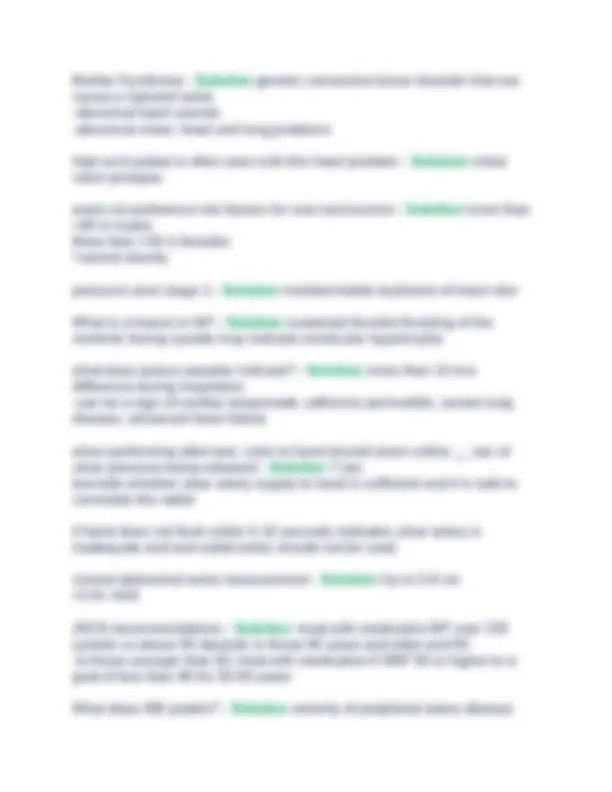
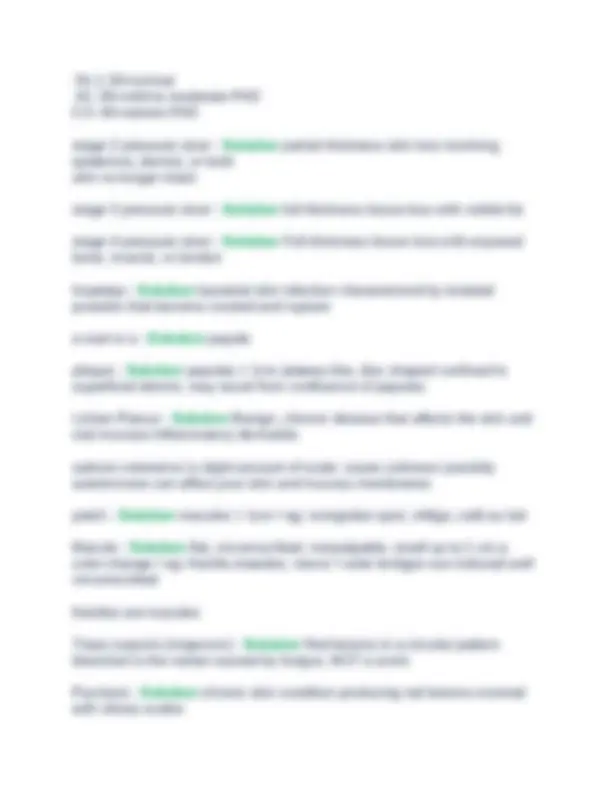
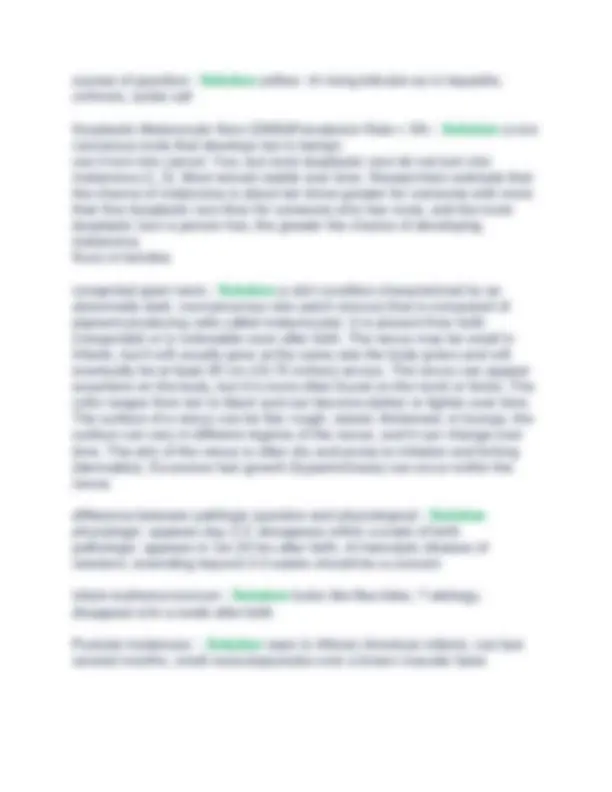
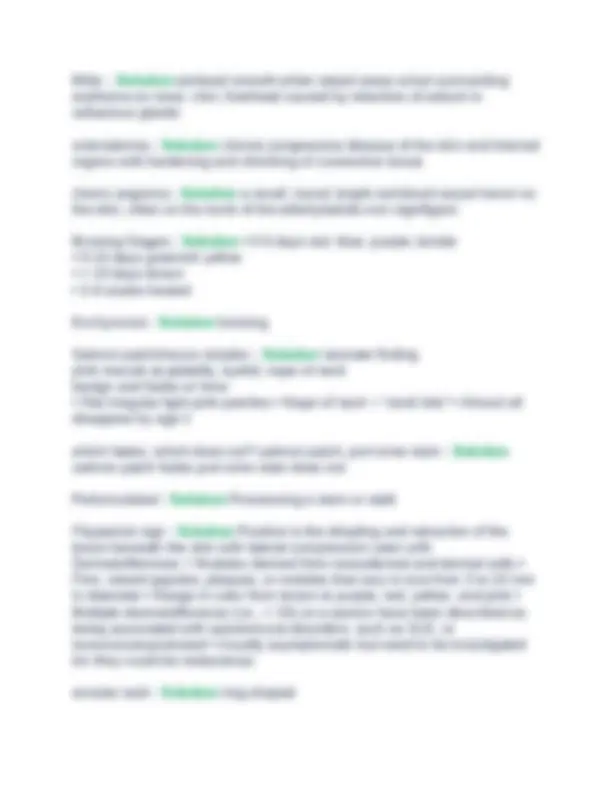
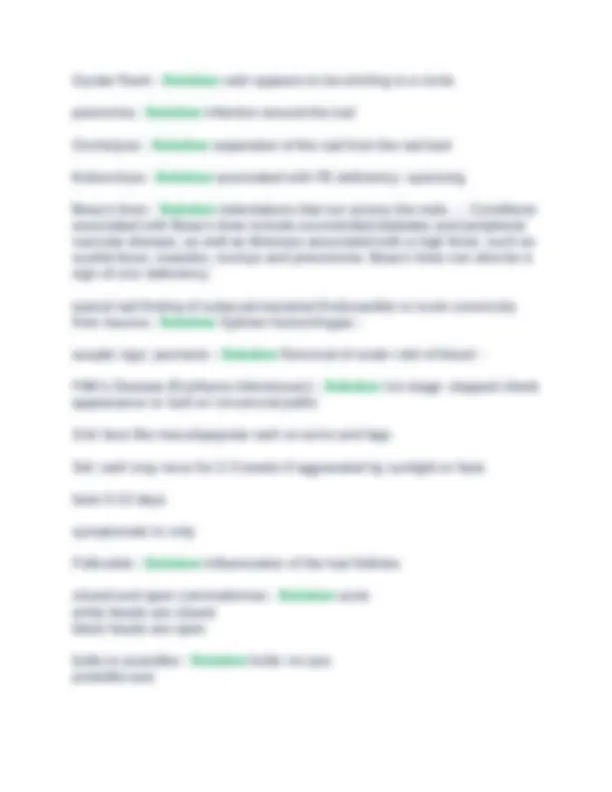
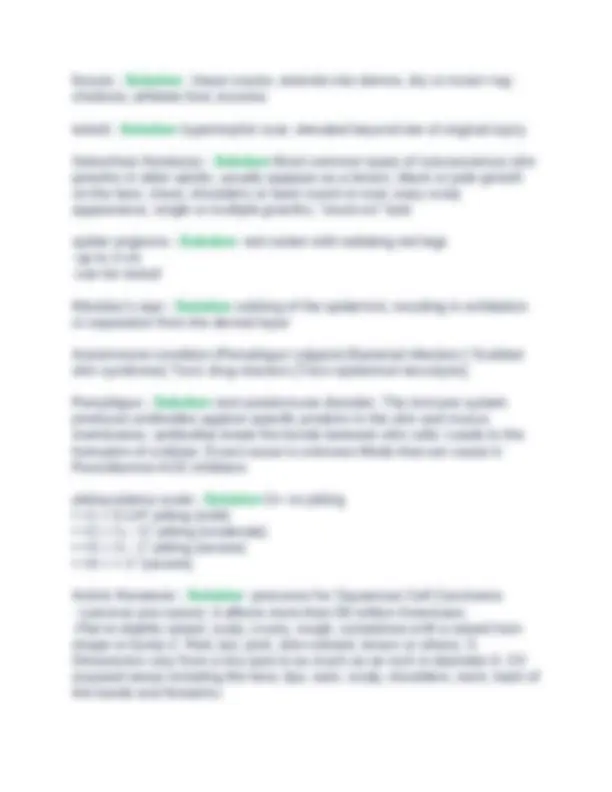
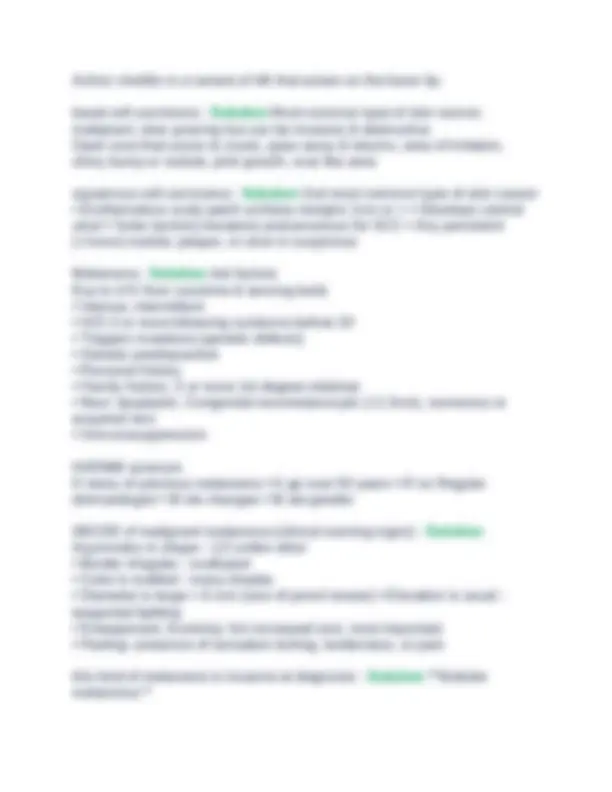
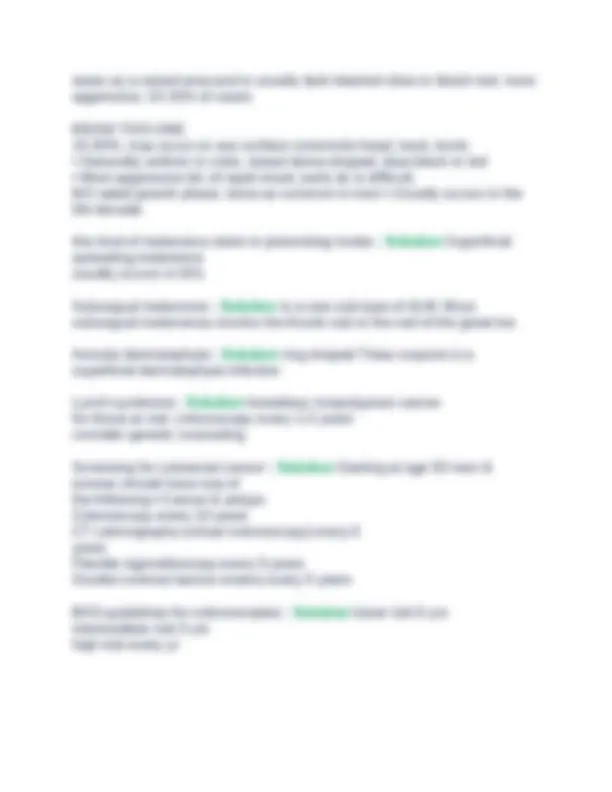


Study with the several resources on Docsity

Earn points by helping other students or get them with a premium plan


Prepare for your exams
Study with the several resources on Docsity

Earn points to download
Earn points by helping other students or get them with a premium plan
Community
Ask the community for help and clear up your study doubts
Discover the best universities in your country according to Docsity users
Free resources
Download our free guides on studying techniques, anxiety management strategies, and thesis advice from Docsity tutors
This resource covers various aspects of clinical examination and screening recommendations. It provides an overview of the components of a review of systems, including different body systems. It also discusses cognitive function assessment, the link between mild cognitive impairment and dementia, and injury/illness prevention. Additionally, it covers topics related to cranial nerves, clinical findings, and coding. The resource also includes information on breast cancer, colonoscopy, heart murmurs, lung sounds, smoking history, and skin conditions.
Typology: Exams
1 / 23

This page cannot be seen from the preview
Don't miss anything!
















what is included in subjective information? - Solution CC, HPI, PMH, SH, FH, ROS objective data includes: - Solution Heard, felt, seen, or smelled. Obtained by observation or physical examination ROS includes - Solution Patient reported-not physical component -constitutional (weight loss, fever, etc.) -skin -HEENT (head, ears, nose, throat) -cardiovascular -respiratory -gastrointestinal -genitourinary -hematologic -immunologic/ allergic -musculoskeletal -neurologic -endocrine -psychiatric OLD CART pneumonic stands for - Solution Onset Location Duration Characteristics Aggravating factors Relieving factors Treatment
Duke Activity Status Index - Solution measure's patient's functional capacity. Rough estimate of peak oxygen uptake. <15=transplant candidate,
20=none to mild impairment Mini Mental State Exam - Solution Concentrates only on cognitive functioning, not on mood or thought processes Standard set of 11 questions, requires only 5 to 10 minutes to administer Useful for both initial and serial measurement, so worsening or improvement of cognition over time and with treatment can be assessed Good screening tool to detect dementia and delirium and to differentiate these from psychiatric mental illness Normal mental status average 27; scores between 24 and 30 indicate no cognitive impairment MMSE score of 20 or less - Solution dementia, delirium, schizophrenia or an affective disorder Montreal Cognitive Assessment (MoCA) - Solution screening for mild cognitive dysfunction; assesses different cognitive domains like attention, visuconstructional, memory, etc. and scored up to 30 points 26 = normal Can weed of problems with people who score normally on MMSE. mild cognitive impairment (MCI) is a risk factor for - Solution dementia Primary prevention - Solution Efforts to prevent an injury or illness from ever occurring. ex. immunizations secondary prevention - Solution Detecting and treating asymptomatic risk factors. ex. health fair screening for HTN or testicular cancer Cranial Nerve 1: Olfactory - Solution sensory, smell Cranial Nerve 2 - Solution Optic
leading causes of death in 15-24 year olds - Solution 1.Accident 2.Homicide 3.Suicide 4.Malignancy 5.Heart disease Council: tobacco usesunscreen useETOH usesexual activityseat belt use bicycle/motorcycle ATV helmetsdiet exerciseETOH & driving, swimming, boatinggun use/possessionScreen:vaccination statussubstance abusedomesticviolencedepressionsuicidal/homicidal ideationPhysical:Ht/Wt/ BP/BMISTI/Pap @ 21HIV @ risk Leading cause of death in 25-44 y.o. - Solution 1.Accident 2.Malignancy 3.Heart disease 4.Suicide 5.Homicide 6.HIV Readdress smoking status at every visit-Obtain detailed FHconcerning malignancies and begin screening-assess all cardiac risk factors including DM & HLD-assess for chronic ETOH abuse, risk factors for hepatitis and other liver disease-consider individual breast screening w/mammography at age 40 leading causes of death in 45-64 y.o. - Solution 1.Malignancy 2.Heart disease 3.Accident 4.Diabetes 5.Cardiovascular disease 6.Chronic respiratory disease 7.Chronic liver disease, cirrhosis 8.Suicide Readdress smoking status at every visit-Consider annual prostate screening w/annual PSA & digital rectal at age 50 earlierinAA of+FH-Begin colorectal screening age 50 w/FOBT, flex sig or colonoscopy-Reassess vaccination status(PV, flu, tetanus)-Consider screening for coronary disease in high risk patients screening rec for those over 65 y.o - Solution +-Readdress smoking status at every visit-
One-time U/S for AA men who smoked 65-75- Consider PFT for all long-term smokers (COPD)-Vaccinate all smokers PV & flu- Screen all post-menopausal women (& men w/risk factors) for osteoporosis- Reassess vaccination status at age 56- Screen for dementia and depression- Screen for visual & hearing problems, elder abuse, & home and safety issues ABCDE approach - Solution Assess risk, anti-platelet, anticoagulants Blood Pressure Cholesterol and cigarette smoking cessation Diet and weight management, DM prevention and treatment Exercise A routine health care examination should be performed every 1-__ years before age 50 and every year thereafter. - Solution 1-3 yrs Lung cancer screening recommendations - Solution •Adults aged 55- who are at high risk for lung cancer •Undergo annual lung cancer screening with low dose CT scans •Recommendation by US preventative Services Task Force •Based on RCT studies that identified patients at risk as 30 pack year history who currently smoke or who have quit in the last 15 years CPT stands for - Solution Current Procedural Terminology -describes the procedures, services or supplies you provide to your patients ICD-10 - Solution International classification of diseases A system to classify and code diagnoses, symptoms, and procedures A NEW patient is defined as - Solution has not received any professional service from provider or another provider (same specialty) in same practice w/in last 3 years An established patient is defined as - Solution has received services from provider or another in group w/in last 3 years
Associated dilated cardiomyopathy with dilated ventricles also contribute to the sound most prevalent cardiac symptom is - Solution fatigue ABI test - Solution compares BP in upper and lower limbs. Calculated by dividing BP in artery of ankle by BP in artery of arm. Expected ABI in a person with heart problems - Solution. Normal ABI range - Solution 0.9-1. lower the number, worse the symptoms pt with c/o SOB that occurs usually after 2-3 hours of sleep causing sudden awakening is - Solution paroxsymal nocturnal dyspnea sleep apnea - Solution a sleep disorder characterized by temporary cessations of breathing during sleep and repeated momentary awakenings heart sound with a short, high frequency click, an opening snap and S2, during the beginning of diastole indicates - Solution mitral stenosis A grey ring around a 80 y. o pt's iris is most likely - Solution arcus senilus- common with old age where would you expect the PMI to be in a patient with dilated cardiomyopathy - Solution shifted laterally, not at 5th intercostal space MCL as it normally would be. Would be louder as you approach the axilla (armpit). In a 30 y.o female with palpitations and lightheadedness for past 6 months with no identifiable pattern would you suspect mitral valve stenosis or prolapse? - Solution mitral valve prolapse mitral valve stenosis is uncommon in young people and is mostly seen in the elderly. mitral valve prolapse (MVP) - Solution Improper closure of the heart valves between the heart's upper and lower left chambers.
Mitral valve prolapse can develop at any age. It can run in families and may be linked to other conditions, such as infection and connective tissue disease. Symptoms may include an irregular heartbeat, palpitations, and shortness of breath. Most people don't require treatment, but some cases may need medication or surgery. mitral valve stenosis - Solution a condition in which the heart's mitral valve is narrowed. This abnormal valve doesn't open properly, blocking blood flow coming into your left ventricle, the main pumping chamber of your heart. Most common cause is rheumatic fever, common in developing countries. Other causes of mitral stenosis are age (calcium deposits build up on the valve), radiation to the chest, congenital heart defects and autoimmune diseases like lupus. Possible symptoms: Shortness of breath: Fatigue: Swollen ankles and feet: Fainting or dizziness: Coughing up blood: Chest pain: signs of acute bronchitis - Solution -paroxysmal episodes of coughing that is dry or productive or mucoid sputum -Soreness in the chest. Feeling tired (fatigue) Mild headache. Mild body aches. Sore throat. in a 21 y.o with fever, SOB, HX of asthma, well controlled with medication, pt has symptoms of upper respiratory infection, when listening to lungs you would expect to hear: - Solution ^wheezing-a symptom of upper respiratory infection signs of abnormal breathing in an infant - Solution Rapid or irregular breathing. Rapid breathing is more than 60 breaths per minute. ...
When the lung field is consolidated (filled with liquid or other solid mass such as tumor or fungus ball), the patient's spoken English long E will sound like a "pure-voweled" long E or a modern English long A When the pt's A turns to E this is known as - Solution positive egophony which indicates consolidation of lung and possible lung collapse. If you ask the pt to say "99" it should normally sound very faint and muffled to you when auscultating with stethoscope over lung fields. If it sounds clear, there is probably lung consolidation of the lung and this is a positive ___________________ test - Solution positive bronchophony test Hyperresonant to percussion in the lungs means - Solution air trapping disorders like: emphysema, COPD, chronic bronchitis Smoking Pack Year History is Calculated How? - Solution # of years smoked x # packs per day. Normal diaphragmatic excursion - Solution 3-5 cm diseases of internal respiratory physiology - Solution what happens at the cellular level diseases of external respiratory physiology - Solution what happens within the lung mechanically Normal tactile fremitus - Solution symmetric bilaterally, vibrations decreases as you go down Tactile fremitus is normally found over the mainstem bronchi near the clavicles in the front or between the scapulae in the back. As you move your hands downward and outward, fremitus should decrease. Decreased fremitus in areas where fremitus is normally expected indicates obstruction, pnemothorax, or emphysema. Decreased tactile fremitus indicates - Solution hyperinflation of lungs-ex. COPD, emphysema, asthma ^ increased tactile fremitis - Solution excess fluid or air can collect in pleural space.
pneumothorax - Solution air in the pleural cavity positive bronchophony - Solution louder, clearer voice sounds Dahl's sign - Solution calluses on legs in patients with orthopnea from COPD-tripod positioning breast cancer signs - Solution single, firm, non-tender lump=suspicious asymmetric breasts are NOT a risk factor Fibroadenoma - Solution usually occurs in young women, single, firm, rubbery lump, poorly delineated, hard to palpate fibrocystic breast disease - Solution numerous small sacs of fluid surrounded by dense strands of fibrous tissue in the breast. Occurs before period, tender, rubbery lumps. If pt presents with lumps, have them follow up after period is over In a pt at high risk of breast cancer with negative fluid aspiration, next intervention should be - Solution refer pt for biopsy high risk pts should also not be on hormone replacement therapy since it increases risk. potential sign of mitral regurgitation is - Solution a thrill during systole at apex on pt's anterior chest mitral regurgitation - Solution mitral insufficiency; incompetent mitral valve allows regurgitation of blood back into left atrium during systole pt with excessive daytime sleepiness, flushed face, SOB, BMI>30, with positive JVP may have - Solution perwickian syndrome aka obesity hypoventilation syndrome metabolic syndrome - Solution A syndrome marked by the presence of usually three or more of a group of factors (as high blood pressure, abdominal obesity, high triglyceride levels, low HDL levels, and high fasting levels of blood sugar) that are linked to increased risk of cardiovascular disease and Type 2 diabetes.
Homocysteinemia - Solution An overabundance of homocysteine in the blood. For a Cysthathionine Synthase deficiency, give B6/restrict methionine. -risk factor for atherosclerosis -increased risk for MI and death -higher risk of VTE, renal disease -lowering levels does not show decline in deaths when studied CRP cardiac risk factor because - Solution indicates inflammation which is a known risk factor for atherosclerosis and CVD events. normal=< than 1. intermediate= 1.0-2. high risk= greater than 3. classes of angina - Solution class 1-CP with strenuous activity class 2-mild limitation-walking up hills, rapidly walking up stairs class 3-CP with low levels of activity like one flight of stairs class 4-angina at rest or with any level of exercise CHADS2 score - Solution risk of stroke in patients with non-rheumatic atrial fibrillation (AF), since AF can cause stasis of blood in the upper heart chambers, leading to the formation of a mural thrombus that can dislodge into the blood flow, reach the brain, cut off supply to the brain, and cause a stroke. CHF= HTN >140/90= Age >75= Diabetes= Stroke (2 pts)= 0 = aspirin/or nothing 1 = aspirin or warfarin
2 = warfarin CHADS score helps predict what - Solution high how the risk is for the patient is anticoagulation is NOT used. Treatment with Coumadin reduces the risk of stroke in atrial fibrillation by about 2/3 (66%), and treatment
Marfan Syndrome - Solution genetic connective tissue disorder that can cause a ruptured aorta -abnormal heart sounds -abnormal chest, heart and lung problems high arch palate is often seen with this heart problem - Solution mitral valve prolapse waist circumference risk factors for men and women - Solution more than
40 in males More than >35 in females *central obesity pressure ulcer stage 1 - Solution nonblanchable erythema of intact skin What is a heave or lift? - Solution sustained forceful thrusting of the ventricle during systole-may indicate ventricular hypertrophy what does pulsus paradox indicate? - Solution more than 10 mm difference during inspiration -can be a sign of cardiac tamponade, adhesive pericarditis, severe lung disease, advanced heart failure when performing allen test, color to hand should return within __ sec of ulnar pressure being released - Solution 7 sec test tells whether ulnar artery supply to hand is sufficient and it is safe to cannulate the radial If hand does not flush within 5-15 seconds indicates ulnar artery is inadequate and and radial artery should not be used. normal abdominal aorta measurement - Solution Up to 3.8 cm 3.8= AAA JNC8 recommendations - Solution -treat with medication BP over 150 systolic or above 90 diastolic in those 60 years and older and 90 -in those younger than 60, treat with medication if DBP 90 or higher to a goal of less than 90 for 30-59 years What does ABI predict? - Solution severity of peripheral artery disease
heriditary Weight gain, smoking, and stress are all documented triggers • + family history of psoriasis is noted in about 30% of suspected cases, but a negative history does not rule out the diagnosis. • Certain medications, such as β-blockers and lithium, can trigger exacerbations of psoriasis. • Psoriasis often presents with what appear to be unrelated findings, such as scalp rash, nail pits, genital involvement, and intergluteal pinking. • Associated with significant psychologic pathology, including poor body image, depression, isolation, increased incidence of drug and alcohol abuse, and suicide. • Almost 30% of psoriasis patients will develop a related form of arthritis called psoriatic arthropathy Lichen Planus - Solution Solar lentigo - Solution "liver spot" in elderly; increased melanocytes vitiligo - Solution loss of pigment in areas of the skin-loss of melanocytes -Increased risk of thyroid disease, DM, pernicious anemia Autoimmune, M=F, 30% familial 1-2% of pop wheal - Solution raised red skin lesion due to interstitial fluid hives a tumor is what kind of lesion - Solution nodule of > 2cm • eg: lipoma, hemangioma - benign or malignant Vesicle - Solution elevated cavity w/ free fluid up to 1 cm, clear serum flows if opened • eg: herpes simplex, varicella, herpes zoster, nodule - Solution solid, elevated, hard or soft, > 1cm may extend deeper into the dermis than a papule chlondyloma - Solution anal warts Molluscum contagiosum - Solution What virus causes small pink benign wartlike tumors and is associated with HIV-positive patients? contact dermatitis often presents as - Solution multiple,easily, ruptured bulla-blisters
erosion skin lesion - Solution focal loss of epidermis, usually doesn't leave scar. Lichenification - Solution Prolonged, intense scratching eventually thickens the skin and produces tightly packed sets of papules; looks like surface of moss (or lichen) "area of itchy dry skin that you describe as thickened, normal in color,w/out drainage, vesicles, edema" scales - Solution flakes or dry patches made up of excess dead epidermal cells Nevis - Solution mole papule - Solution can be type of acne- but doesnt have to be acne, just describes shape and characteristic of a skin lesion. Doesn't have pus, a small, raised, solid pimple or swelling, often forming part of a rash on the skin and typically inflamed but not producing pus. solid, elevated, circumscribed, < 1cm • eg: elevated nevus (mole), molluscum, wart (verruca) pustule - Solution acne lesion elevation of skin containing pus Milia - Solution small raised white spots on nose, chin, and forehead infant Miliaria rubra - Solution scattered vesicles on an erythematous base, sweat gland obstruction, disappears w/in weeks Eccrine glands produce - Solution thin and watery sweat appocrine glands - Solution a sweat gland that secretes a viscous, milky fluid into a hair follicle (as in the armpit or groin), is lined with a single layer of usually columnar cells with eosinophilic cytoplasm, and typically does not become active until puberty when bacteria interacts with=body odor
Milia: - Solution pinhead smooth white raised areas w/out surrounding erythema on nose, chin, forehead caused by retention of sebum in sebacious glands scleroderma - Solution chronic progressive disease of the skin and internal organs with hardening and shrinking of connective tissue cherry angioma - Solution a small, round, bright red blood vessel tumor on the skin, often on the trunk of the elderly/adults-non signifigant Bruising Stages - Solution • 0-5 days red, blue, purple, tender
10 days brown
Gyrate Rash - Solution rash appears to be whirling in a circle paronchia - Solution infection around the nail Oncholysis - Solution separation of the nail from the nail bed Koilonchyia - Solution associated with FE deficiency -spooning Beau's lines - Solution indentations that run across the nails. ... Conditions associated with Beau's lines include uncontrolled diabetes and peripheral vascular disease, as well as illnesses associated with a high fever, such as scarlet fever, measles, mumps and pneumonia. Beau's lines can also be a sign of zinc deficiency. typical nail finding of subacute bacterial Endocarditis or more commonly from trauma - Solution Splinter hemorrhages - auspitz sign, psoriasis - Solution Removal of scale =dot of blood - Fifth's Disease (Erythema Infectiosum) - Solution 1st stage: slapped cheek appearance or rash w/ circumoral pallor 2nd: lace like maculopapular rash on arms and legs 3rd: rash may recur for 2-3 weeks if aggravated by sunlight or heat lasts 5-10 days symptomatic tx only Folliculitis - Solution inflammation of the hair follicles closed and open commedomes - Solution acne white heads are closed black heads are open bulla vs pustulles - Solution bulla -no pus pustulles-pus